Voyager 1 at Saturn
Visualization
My 2008 demo reel shows what Voyager 1 could see as it sped past Saturn in November of 1980. You can also watch this at 720p on Vimeo.
I animated and rendered this in LightWave version 7, which was already six or seven years old in 2008. The original SD resolution version was rendered on two machines that were at least as old as the software, and it took a couple of weeks. The movie was cut together in Sony Vegas and burned to DVDs. Somehow, this was good enough to get me my dream job. If there's a lesson in that, it's Don't let old tools or modest means hold you back. Find a way.
In 2013 I re-rendered the whole thing at HD resolution (still in LW 7!) using the same scene files. The HD movie was put together in Adobe Premiere CS5.
Titan
Throughout the animation, the camera's path matches Voyager's. In the first scene, we appear to be on a collision course with Titan. Voyager 1 was sent perilously close to Saturn's largest moon in the hope that its cameras might penetrate Titan's thick atmosphere.
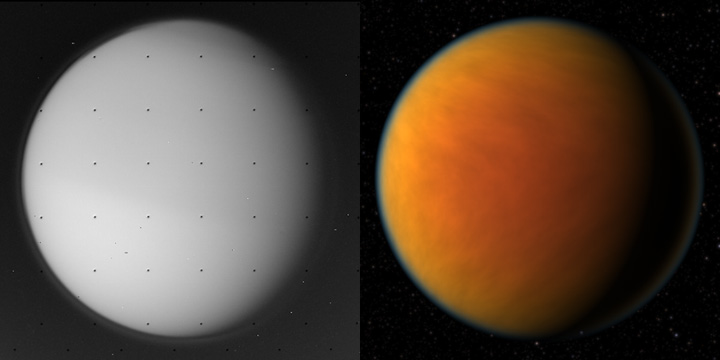
A Voyager 1 image of Titan (C3491749, above left) taken at 2:48 UT on November 12, 1980, compared with the rendered version. The faint haze of the upper atmosphere is visible even on the shadowed side of the moon.
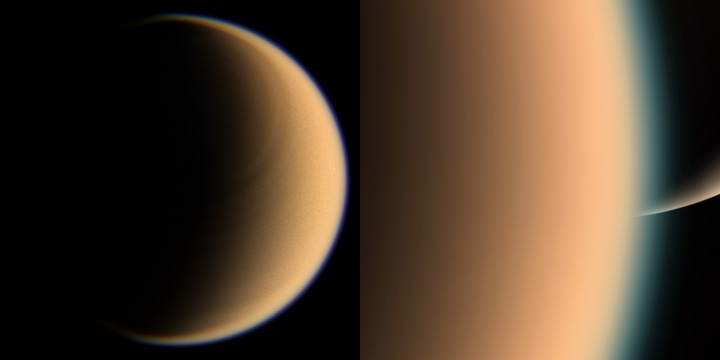
In these images taken by Cassini in 2007 (PIA08879, left) and 2005 (PIA08351), Titan's lower atmosphere is an opaque, nearly featureless orange, while at higher altitudes it becomes a thin, transparent blue.
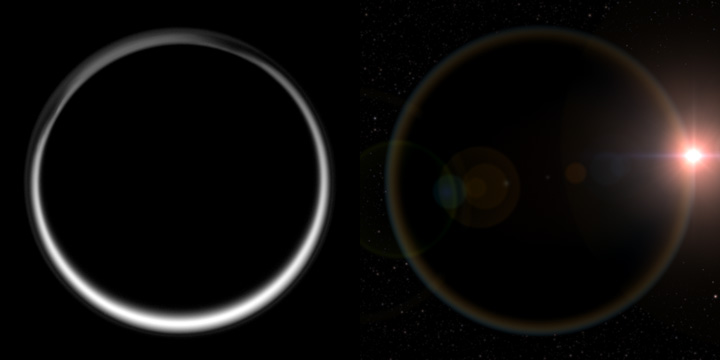
Backlit by the Sun, Titan's atmosphere forms a glowing halo. The image on the left was taken by Cassini in 2007 (PIA09007).
Tethys
Shortly after the encounter with Titan, Tethys emerges from behind Saturn. In the animation, it's a mere dot traveling toward the upper left of the frame.
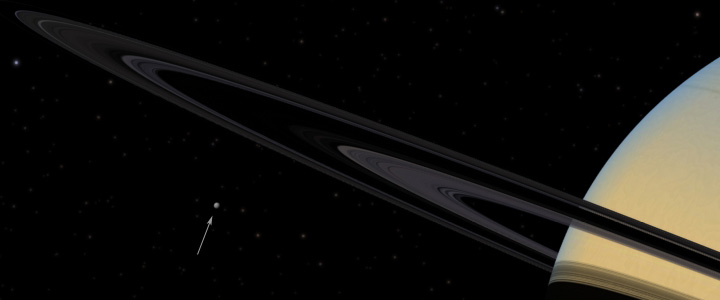
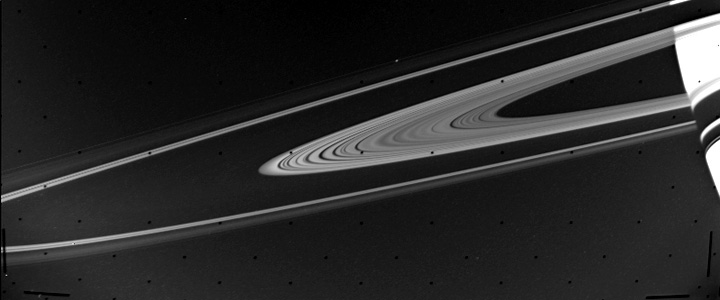
This is the view from Voyager 1 at 10:04 UT on November 12 (C3492654), the time of the animation still above. Tethys is just out of frame. The white dot riding along the near edge of the ring system is the small moon Prometheus, which had been discovered by Voyager 1 only weeks earlier. It's too small to see in the animation.
Mimas
The animation follows Mimas as it flies across the face of Saturn. Compare this to a Mimas and Saturn image from Cassini.
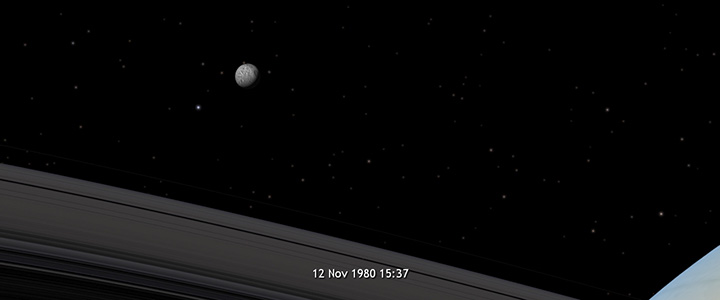
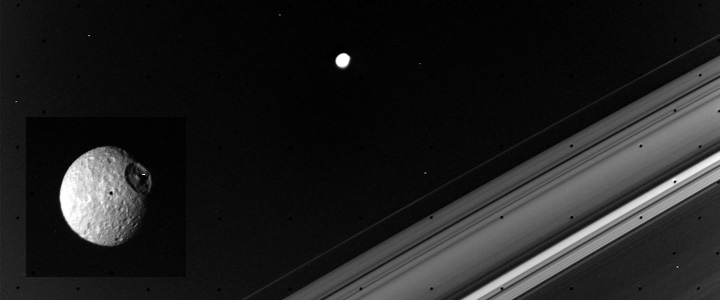
The view from Voyager 1 at 15:37 UT on November 12 (C3493353). The inset (C3493350) is a close-up taken at exactly the same time. It shows Mimas's most prominent feature, an enormous, eye-like crater that makes the moon look like a Death Star.
Saturn
The animation ends on what is probably the most famous Voyager 1 imagery, its parting view of Saturn. After this, its planetary mission finished, Voyager 1 left the plane of the solar system on a path to interstellar space.
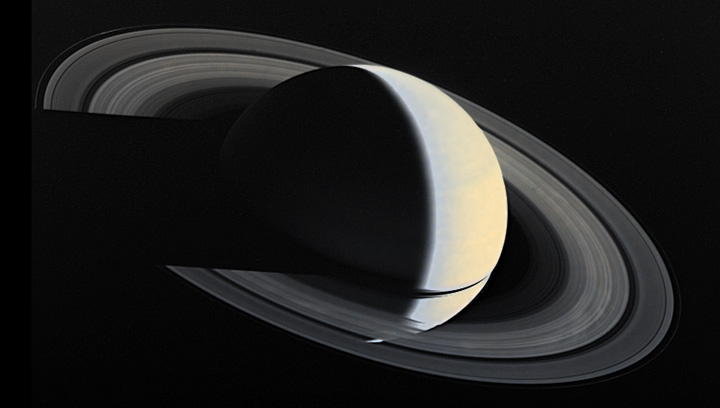
The Voyager 1 image above (PIA00335) was taken November 16, 1980, three days after the animation ends. My rendering for the same date, matching the tilt of the camera, is below. Note that my ring model is missing the delicate F Ring. The faint dot at about one o'clock is Mimas, which I think is also visible in the Voyager image, although it's by no means easy to see. The even fainter dot above Mimas, near the top edge of the frame, is Enceladus.

Stars
The stars in the animation were rendered with the same tools I've mentioned elsewhere. Real images from Voyager don't contain stars—the white specks you can see in some of them are artifacts. But in solar system visualization, the stars provide an important orientation cue. Without something in the background, it's often hard to tell which way the camera is moving or pointing.
Epilogue
The Voyager imagery is archived on NASA's PDS (Planetary Data System) Imaging Node. I've mostly used the raw images on Volume 4 of the archive. The image numbers here correspond to filenames in the archive.
Computer graphics pioneer Jim Blinn famously created an animation a lot like this one, almost 30 years earlier. You can see it here. Blinn and his colleagues basically invented modern solar system visualization.
I didn't consciously set out to remake Blinn's work of art. I'd created a number of elements that a Saturn movie would demo well — a rings shader, a star plotter, a JPL Horizons ephemeris reader, a keyable date/time module to drive body motions and Sun angle — and I happened to choose Voyager's path as the path of my camera. I hadn't seen the Blinn version since the 1980s. It wasn't until someone else pointed it out that I realized I'd unwittingly made a tribute to his foundational work.
There is a lot of software now (NASA Eyes, Celestia, OpenSpace, and many others) that makes this sort of animation relatively easy.
© Ernie Wright
Last modified 13 August 2023
